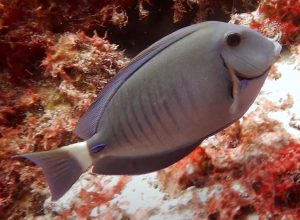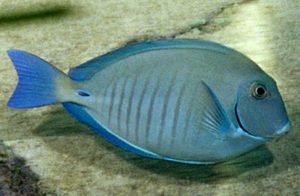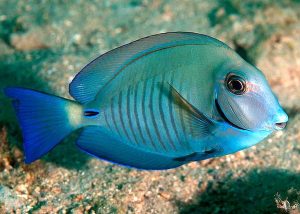The Doctorfish Tang (Acanthurus chirurgus) more commonly known as Doctorfish Surgeonfish, or Doctorfish to tropical fish keeping enthusiasts, is found in the Western Atlantic Ocean from Massachusetts to Brazil, including Bermuda and the northern Gulf of Mexico. In the Eastern Atlantic, it ranges to the tropical west coast of Africa (Senegal), and has been more recently identified in the central Mediterranean Sea.
The Doctorfish Tang is a dinural species that is typically found alone, in pairs, and as juveniles in loose agregations among the rocky outcrops and shallow coral reefs of its range, where it spends its daylight hours grazing on algae and organic detritus at depths to 130 feet. They are often found traveling with schools of Ocean Surgeonfish (Acanthurus bahianus) foraging through inshore seagrass beds.
At night, Doctorfish Tangs shelter in the crevices and caves along the reef to escape predators while they sleep.
Juvenile Doctorfish Tangs, Blue Tangs (Acanthurus coeruleus), and Sergeant Majors (Abudefduf saxatilis) in the Southwestern Atlantic around the Fernando de Noronha Archipelago, often set up cleaning stations where they pick off molted skin, parasites, and algae growths from Green Sea Turtles (Chelonia mydas).
The Doctorfish Tang has a blue gray to dark gray body color with darker brown vertical stripes. Males are visually indistinguishable from females in size and color.
The Doctorfish is best housed in a mature FOWLR or reef tank of at least 100 gallon capacity with a finely crushed coral or sandy substrate, and substantial quantities of mature algae encrusted live rock arranged into crevices, caves, and overhangs for them to graze and hide among. Like many tangs, they require plenty of free swimming space, a good amount of water movement, and at least one shaded area in the tank.
Although Doctorfish Tangs are reef safe and will ignore coral polyps in your reef setup, they may occasionally take an interest to mussels or decorative clams. They will consume small crustaceans if an ample supply of microalgae is not present for them to graze on.
Except for conspecifics, the Doctorfish is generally peaceful towards most tank mates. In an extremely large community or reef tank with plenty of free swimming space, up to three or four can be housed together, especially when housed with other tang species. To reduce aggression between the tangs, introduce all the fish into the tank at the same time and provide plenty of algae for them to graze on.
Some good Doctorfish tankmates include Angelfish like the Emperor Angelfish, Anthias, clownfish, damselfish, Gobies (Neon Goby or Mandaring Goby), hawkfish, pufferfish, Planktivorous triggerfish (Picasso Triggerfish or Clown Triggerfish), eels, and other reef species of similar temperament. Avoid introducing other algae eaters into a FOWLR tank to minimize territorial disputes over food.
The teeth of Doctorfish are shaped for scraping algae and plant matter from the rocks they graze on. Because they swallow their food whole, they have developed a gizzard like organ in their intestine filled with particles of sand that is used to grind up algae prior to initiation of the digestive process.
Because very large aquariums are required for breeding and male and female Doctorfish Tangs, they have not been bred in an aquarium environment.
In their natural habitat Acanthurus chirurgus display the egg scattering spawning activity typical of the family Acanthuridae. They are broadcast spawners that gather in groups during the evening hours and pair up during spawning. After a brief courtship ritual, the male and female swim up into the water column to the surface where the female releases her eggs and the male immediately fertilizes them.
The small planktonic eggs (less than a millimeter in diameter) contain a droplet of oil and drift with the current along the surface until the translucent, plankton like larvae hatch out, usually within 24 hours of fertilization. The laterally compressed diamond shaped larvae have large eyes and pectoral fins. When the scales, dorsal, and anal fins begin to develop at about 1/4 inch in length, the larvae move to the bottom where they continue to grow into small Doctorfish. The juvenile Doctorfish Tangs reach sexual maturity in about nine months.
In their natural habitat Doctorfish Tangs spend their entire day in search of microalgae, seaweed, and any meaty bits of food they can find. In an aquarium environment they will graze on algae on the live rock and corals throughout the day. It is important that they are fed plenty of marine based seaweed and algae to strengthen their immune systems, reduce aggression, and improve their overall health.
Nori, Spirulina Flakes, herbivore flake foods and some meaty live or frozen foods like Mysis shrimp, krill, mussels, and brine shrimp should occasionally be offered to balance their diet and activate their metabolism. Doctorfish Tangs swallow their meals whole, so provide them with small portion sizes. Sea Veggies, Seaweed Salad, and Ocean Nutrition are good, easy to use products.
Dried seaweed (Nori) tied to a rock or clamped onto a veggie clip or Chaetomorpha should be fed at least 3 times a week to avoid having a hungry tang in your tank.
Although the Doctorfish Tang (Acanthurus chirurgus) is not often seen in the aquarium trade, they are available to tropical fish keeping enthusiasts from specialty fish shops, online wholesalers, retailers, and trans shippers at the following approximate purchase sizes: Small: 1-1/4″ to 1-3/4″, Small/Medium: 2″ to 3″; Medium: 3″ to 4″, Medium/Large: 4″ to 5″; Large: 5″ to 6″. Prices start at around $25.00 for a tiny specimen to over $150.00 for adults.
Minimum Tank Size: 100 gallons
Aquarium Type: Reef or FOLR
Care Level: Moderate
Temperament: Semi Aggressive
Aquarium Hardiness: Hardy
Water Conditions: 72-79° F, dKH 8-12, pH 8.1-8.4, sg 1.020-1.025
Maximum Size: 16″
Color Form: Gray, Brown
Diet: Omnivore
Compatibility: Reef or FOWLR
Origin: Western Atlantic, Senegal
Family: Acanthuridae
Lifespan: 7 – 8 years (28 years in the wild)
Aquarist Experience Level: Intermediate




